
Unsinkable in the Dead Sea
First we drive to the capital Amman where we set up camp on the large, very nice grounds of the Theodor-Schneller-School, a self-help project for orphans. We can really recommend camping here. The few dinars we pay are spent for a good cause. We need the days in Amman primarily to settle some organizational matters. First the visa must be registered at the police station because we intend to stay longer than 14 days in the country. Then we have to go to the Libyan Embassy to apply for a transit visa to be allowed to travel to Tunesia via Egypt. We are very surprised to hear from the consul in charge that we cannot get a visa without a special permit from Tripolis and that he is not able (or willing) to support us in getting this document. All we can do is ask a licenced Libyan tour operator. This agency is willing to help if we pay them approximately US$ 500 to 800. This is quite expensive for a transit of only a few days! A friend of us, a member of the German Parliament, therefore tries to help us by writing to the Libyan Ambassador in Germany - we are still waiting for an answer. Since ferry traffic from Haifa (Israel) to Piraeus (Greece) was stopped for security reasons, the only alternative for us would be to drive along the coast of the Mediterranean Sea and travel through Turkey. Visiting the Iraqi Embassy doesn' t help either. Our visa application in Tehran has not been processed after more than four weeks, but we are given the tip to contact someone from Iraq Airlines who is able to get a group visa within a few days. Our problem is that such a group must consist of at least five people who actually travel together. Jordanian people do not count in this case, otherwise we could have asked someone on the street walking by. Since we couldn' t find others to join us, we are unfortunately not able to discover this very interesting part of the ancient Silk Road. You can imagine that we leave Amman being quite disappointed. We visit the country' s attractions anyway.
 Unsinkable in the Dead Sea |
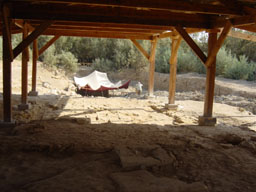 Baptismal place of Jesus |
 Narrow Jordan |
For the night we retreat to Mount Nebo (802 meters), the place from which the Israelis, led by Moses, looked at their new Promised Land for the first time. From our camp we see the lights of Jericho and Jerusalem in West Jordan in the darkness. We are shocked to hear at the same time, listening to our short-wave transmitter, that practically in front of us another bomb just exploded and killed three people.
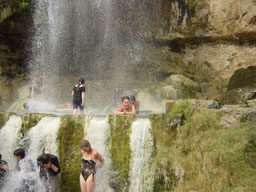 Taking a shower |
In Kerak we visit the ruins of a crusader fortress. This is only recommendable if you did not have the chance to see the better maintained fortresses in Syria. It is however worth visiting the smaller excavation sites along King' s Highway if you have enough time. To avoid our "pillar and ruin syndrom" we first of all enjoy the beautiful nature around us.
 Camping in Dana |
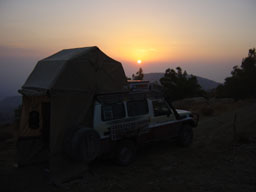 Sundown in Dana |
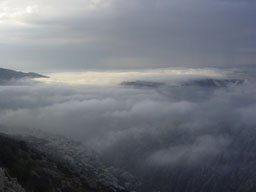 Clouds around us |
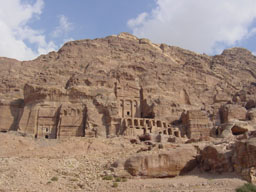 Petra |
 Bedouin police |
We access the city by going through a very narrow canyon (called siq) only a few meters wide. The rock faces are partly over 100 meters high and of multi-colored sandstone. At the canyon' s end we can see through a narrow crevice the Treasury with its huge facade. It is chiselled into the red sandstone and made out of one piece. As all the tourists, we continue walking through the canyon coming along various small and large stone graves until we arrive at the amphitheatre. An original sandstone staircase leads us to the rock' s peak with a sacrificial altar. We have a magnificient view to the city of Petra. Its temples, monasteries and graves are chiselled into the red stone. We identify streets, former buildings and a lot of debris, certainly covering up many secrets of the past. We continue our hike until we arrive at the temple of the pharao' s daughter, drink the most expensive tea of our journey and return.
 Mysterious Petra |
 Petra' s Treasury |
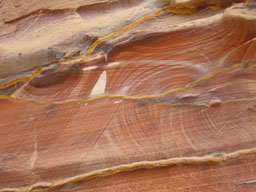 Kaleidoscope of colours |
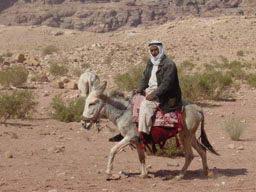 Bedouin riding a donkey |
An additional excursion leads us through a water tunnel of the Nabatea. We walk through another wadi and hike far away from the typical tourist paths. If you really try, it is possible to find absolutely quiet and beautiful spots in Petra so that you can relax after the loud hustle and bustle of the bazaar with all the saddle camels, donkeys, horses and carts and the countless traders.
 Climbing in a wadi |
 Wadi scenery near Petra |
 Wadi scenery near Petra |
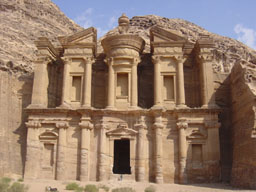 Facade out of one piecek |
Shortly before Aqaba we enjoy the wonderful desert of Wadi Rum. Here Lawrence of Arabia and his Arab comrades-in-arms played their "cat-and-mouse game" with the Turkish army beginning of the previous century on behalf of the British. The vast and quite rough landscape puts us to a real (navigation) test. Our map is inaccurate and hardly a help. Once again we are happy to have a GPS on board. With our 80 liters of water and enough food supplies we start our tour and enjoy this unique scenery for three particularly beautiful days.
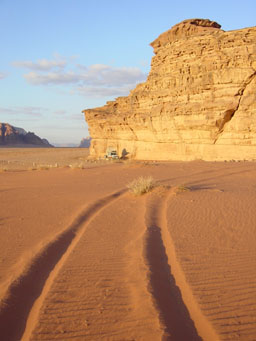 Wadi Rum |
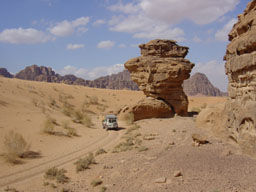 Wadi Rum |
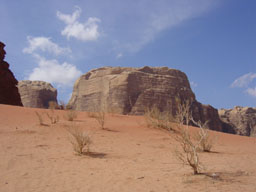 Wadi Rum |
At this time we get good news from the Libyan Ambassador in Germany: An exception was made and we will receive a transit visa for Libya in Cairo. Now we can enjoy the days in Wadi Rum without worrying about how and where to travel next. We do some hiking.
 Burdah Bridge |
We spend the last night in the middle of the desert directly at the route of the Desert Cup, a 168 kilometer long ultra-marathon. 231 runners have signed up for this year' s challenging run. Ute, herself a marathon runner, feels obliged to cheer up those lonely athletes running through the desert. In contrast to the Berlin marathon, the relation here at two o' clock at night is one runner to one spectator. The runners however looked at us as if we were a fata morgana watching them run here in the desert. By the way: The record for running 168 kilometers through fine desert sand is 18 hours and 35 minutes.
 Desert marathon |
Unfortunately the few days of Wadi Rum must be seen as offroad paradise. According to new plans a guide is mandatory and external cars are no longer permitted in this national park.
To continue to Aqaba we take the desert route which abruptly ends after almost 50 kilometers at the Gulf of Aqaba. We thus spend a few days at the beach inspecting the fantastic (and practically indestructable) coral-reefs. What a contrast when coming from the desert and diving into this underwater world! Here we meet a lot of other tourists who plan to travel via Egypt and Sudan taking the Eastern route to South Africa. We also have to take the ferry from Aqaba to Nuweiba in Egypt, although taking the coastal road through Israel would be much shorter (and cheaper). Would we have stamps of the Israeli/Egyptian border in our passes, then we couldn' t enter into Libya or return to Syria.
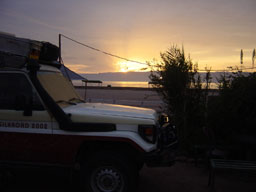 Aqaba |